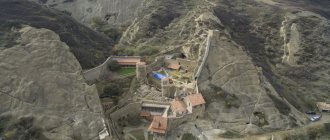Monastery
The monastery of the same name is also associated with the name of this saint. This is a whole complex of cave monasteries dating back to the 6th century, approximately 60 kilometers from Tbilisi in the area of the Georgian-Azerbaijani border.
The main one is the Lavra of St. David, located on the northern slope of the mountain. This is the oldest monastery of the entire complex, founded by one of the thirteen Syrian fathers in the natural cave of Gareja.
In the 9th century, a refectory and the Transfiguration Church were built in the vicinity of this place. After this, the monastery suffered more than once from invasions of foreigners. In the 11th century it was plundered by the Seljuks, and in the 13th century. - Mongols. At the beginning of the 15th century, it was severely devastated by Tamerlane, and about a century later by the Persian Shah Abbas I.
The first attempts to restore the monastery began to be made by King Teimuraz at the end of the 17th century. In fact, its revival dates back to 1690, when the Monk Onufriy Machutadze became its rector. He managed to restore the monastery to its old rights, return the lands that previously belonged to it, erect fortress walls to protect against enemies, and build refectories.
In the 18th century, the monastery was again subjected to numerous attacks and devastation, then interest in it disappeared after the appearance of secular and theological schools in various cities of Georgia. They remembered him only during the times of Soviet stagnation. Electricity was installed here, a road was built, and several houses for the monks were built.
It is here that the holy relics of David of Gareji are kept. Orthodox Georgians note that over the long centuries of its existence, the monastery was repeatedly attacked and destroyed, but still managed to survive, playing an important role in the spiritual development of Georgia.
David chose the city of Tiflis for preaching
John's disciple David of Gareji went to the city of Tiflis to preach. On Mount Mtatsminda, he chose a wretched cave to live in, and settled there with his disciple Lucian.
On Thursdays, the Monk David came down from the mountain to the city and preached the Holy Gospel to the residents. This is the news of the birth, earthly ministry, miracles, death on the cross, resurrection and ascension of Jesus Christ.
His preaching caused great discontent among the fire-worshipping priests. One day they persuaded a pregnant woman to slander the monk, and gave her a decent amount of money.
When David came to trial, he was accused of having an unholy relationship with a woman, which is why she found herself in this position.
Saint David performed a real miracle: he touched the woman’s stomach with his staff and asked if he was the father of the child.
A loud answer “no” sounded from her womb, and then her father’s real name was called.
According to legend, this woman immediately turned into stone. This is how the saint showed the greatness and power of God. After this he was completely acquitted.
The saint showed the greatness and power of God.
After this incident, the saint asked God, and a holy spring gushed out on that very mountain. Even now they say that that spring still flows, and many are healed after drinking the holy water.
After what happened, the monks left the city. They came to one rocky place called Gareji. Here the monks built cells for themselves, where they began to pray. They had to endure a lot, especially the lack of water and food.
David and his disciple Lucian ate grass and various roots. Rainwater was used for drinking.
One day all the plants dried up, and Lucian asked David what they should do, because there was no food at all. To which David replied that the Lord would take care of them.
After which many deer came to the monks’ cells, and David was able to milk them. From that time on, animals very often appeared near their places.
Soon the same hermits as David and his disciple began to come to the cells and began to settle nearby. This is how the David-Gareji monastery, known to many, arose.
The David-Gareji Monastery is the oldest monastery of the complex, the Lavra of David, founded at the beginning of the 6th century by the Syrian monk David, one of the 13 Syrian fathers, who settled in the natural cave of Gareja.
In the same VI century. his students and followers Dodo and Lucian founded two more monasteries - the monastery of Dodo and Natlis-Mtsemeli.
Prayer to the saint
The corresponding prayer should be addressed to the Christian saint David of Gareji. You now know what they pray to him for. Several dozen people come to him with such requests every week.
Oh, all-bright, God-praised Abba David, holy of God! You, by the power of the good Law-giver, have appeared to us, bound and overcome by the snares of the evil one, as a mentor in repentance and a helper in prayer. For this reason, you have been given many gifts of grace and miracles, the resolution of our sins and the remission of sins, the healing of illnesses and the driving away of the devil’s slander. Also, by your fatherly mercy in the divine understanding, by your many laborious prayers and supplications, and especially by your unceasing intercession for us, may the Lord God raise us, who have fallen into sin, with His invincible power against every visible and invisible enemy, so that by giving thanks to your holy memory, with desire We desired to worship the Eternal God in the One Trinity, Father and Son and Holy Spirit, now and ever and unto ages of ages. Amen.
In the last years of his life, David made a pilgrimage to the Holy Land
The legends also indicate that David had a presentiment of his death and finally wanted to make a pilgrimage to the Holy Land of Jerusalem. He went there with his disciples.
But when he came to that very place, he refused to step on the ground on which the Lord himself walked.
He asked the travelers to pray for him and move on. But David himself remained. He took only three stones with him and went back.
After this, an Angel appeared to the Patriarch of Jerusalem in a dream, who said that Saint David had taken away all God’s Grace from his land.
The Patriarch immediately sent his messengers for the saint, who then took two stones from him, telling him that he had a dream.
20 May 604
David of Gareji died on this day
Soon David died. The date of his death is known - May 20, 604. This happened on Ascension Thursday. Since that time, the memory of the saint has been revered on this day.
His body rests in the Transfiguration Church of the David-Gareji Lavra. As is customary in Georgia, his relics are in the tomb.
This is exactly what the place where the relics are kept looks like. According to Georgian customs, the relics are kept in a tomb. Church of the Transfiguration of David-Gareji Lavra
Some of his holy relics were taken in 2000. After the tomb was opened, they were once again convinced of its inviolability. The remains of the saint lay, as before, completely unchanged.
How to get to David Gareji from Tbilisi
The complex is located 60 km from Tbilisi. From early spring to mid-October, buses run from the capital that will take you to the Shrine and wait 3 hours. The trip will cost 25 lari ($9.25). The bus starts from Freedom Square from the street. Pushkin at 11.00 daily. You can take a taxi from Tbilisi - this is the most convenient way to get there. A one-way trip will cost from 75 GEL ($27.75), if you ask to be taken back, it’s quite possible to negotiate for 60 GEL in both directions ($22.2).
There is also a more budget option - get to Sagarejo, and then take a taxi. Minibuses start from Tbilisi (from Samgori) every 20-30 minutes, starting from 8.00 to 20.00 (however, this minibus is sometimes canceled). Ticket price is 4 lari ($1.48). Already in Sagarejo you can take a taxi, the drivers are very accommodating - they are ready to take you to the Lavra for only 30 lari ($11.1). Buses also start from Samgori to the village of Udabno, from here it is about 15 km to the monastery complex. They only run on Mondays, Fridays and sometimes Thursdays. The ticket costs 5 lari ($1.85). Arriving in Udabno, you can have a delicious lunch in the open air at the Oasis Club restaurant. From the hill you can see amazing panoramas of the steppe. Stay here for a couple of hours and ride luxurious horses across the steppe - the entertainment is simply excellent, and will cost inexpensively - from 25 lari ($9.25). After resting, you can take a taxi to the monastery complex - about 10 lari ($3.7).
Attention! Prices shown here are from two years ago. Considering how prices have increased during this time on other routes, there may also be a two-fold increase here.
Excursion to David Gareji from Tbilisi
Perhaps this is the best option to see the Lavra and Kakheti in one day. And of course, from the guide you can hear the full history of these places and learn interesting details. For a trip to such a place, a guide with historical education is best suited. For example, George and his excursion David-Gareji Monastery Complex - Bodbe Monastery - Sighnaghi.
How to get there from Batumi
If you are coming from Batumi, it is better to get to Tbilisi, and from there by minibus. Buses from the resort town, as well as minibuses, run regularly. On average, the trip will cost 20 lari ($7.4). A train runs from Makhinjauri station (near the resort Batumi). It starts at 22.10 and arrives in the capital at 7.00. The journey will take about 8 hours, the ticket costs from 20 lari ($7.4). There is a more comfortable and faster option - a modern high-speed train from Batumi. You need to spend 5 hours on the road, and you are in Tbilisi. Prices start from 19 lari ($7.03).
Complete transport guide: Traveling around Georgia - all types of transport for tourists








